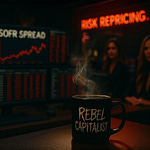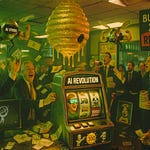“Every bubble starts as a miracle. The trick is knowing when the miracle becomes math.”
If you’ve been near a stock chart, a cocktail party, or a Thanksgiving table lately, you’ve felt it.
The hum. The heat. The hype.
Artificial intelligence…the latest miracle of modern markets…has wrapped itself in the glow of inevitability. We’re told it will change everything: our jobs, our homes, our portfolios, our very sense of reality.
But peel back the promise, and you find something stranger.
Behind the glossy investor decks and the trillion-dollar headlines lies a business model that depends on math that doesn’t work.
That’s not hyperbole. It’s the actual conclusion reached by Kuppy…hedge fund manager, blogger at pracap.com, and occasional prophet of inconvenient arithmetic.
When he sat down with George Gammon, the laughter was real…but so was the concern.
What follows isn’t a rant against technology. It’s a post-mortem written before the patient dies.
The Math Problem No One Wants to Solve
Every mania has its formula. The AI boom’s is simple:
Spend hundreds of billions building data centers.
Assume those centers somehow pay for themselves.
Hope the revenue shows up later.
This year alone, roughly $400 billion is being sunk into AI infrastructure…steel, chips, concrete, and cooling fans the size of jet turbines.
These facilities depreciate faster than a smartphone; three to five years and they’re obsolete. Some never even make it that long.
Let’s do the math.
At a generous 25% gross margin, investors would need $500 billion in annual revenue just to break even on this year’s build-out.
To earn a modest 10% return? Try $1 trillion.
Next year, when construction ramps up again, that figure balloons toward $2–4 trillion.
For context, the entire U.S. Department of Defense spends about a trillion dollars a year.
The entire AI industry’s revenue today? Somewhere around $15–20 billion.
A 30× leap…just to get even.
“This has zero chance of making money,” Kuppy said flatly. “It’s Uber on a galactic scale.”
Gammon nodded, noting how Nvidia’s Jensen Huang seems allergic to specifics. The grand vision remains a story without a spreadsheet.
So if the math doesn’t work, what’s holding up the illusion?
The Circular Economy Trap
The dream, of course, is automation. Replace armies of salaried humans with tireless code. Swap payroll for servers.
Gammon pitched it straight: maybe this is just the early innings…today’s $12 billion in consumer AI spending could explode once corporations redirect their budgets.
Microsoft, for instance, might swap $50 billion in staff costs for an AI subscription from OpenAI.
That’s the fantasy.
Jensen Huang even claims that half the world’s $120 trillion GDP…about $60 trillion…is “computer-based labor” ripe for disruption.
Kuppy isn’t buying it. His model caps the realistic target closer to $5 trillion, and even then, automation eats its own tail. Replace high earners and you erase the very consumers who drive spending. “Even if they win,” he said, “they don’t win.”
Yes, AI might one day handle doctor visits or tax prep, but for now it’s a glitchy intern…one who hallucinates legal advice and forgets to file forms.
Useful, yes. Trustworthy? Not yet.
Meanwhile, the hyper-scalers are planning to plow $5 trillion into new capacity by decade’s end…seven times the inflation-adjusted cost of America’s entire highway system. Those highways transformed society. This wave mostly generates memes.
Revenue may climb to $50 billion, but that’s top-line, not profit…and the open-source competition improves 25–50% per year, undercutting any attempt to charge for it.
The irony? The better AI gets, the less anyone can sell it for.
No Moat, No Mercy
In most great tech stories, there’s a moat…a barrier to entry, a sticky network effect, something that locks customers in.
AI has none.
ChatGPT today, Claude tomorrow, Gemini next week. One click, and loyalty resets. “There’s no network effect here,” Gammon observed.
Microsoft tries to bundle AI into Azure cloud packages, but that just drags down margins.
Replace a $100k employee with $90k worth of AI services and you’ve saved ten grand…until Anthropic offers the same output for $50k, then OpenAI for $40k, then Claude for $30k.
The race ends just above electricity cost.
“It’s funded,” Kuppy quipped, “until someone refuses.”
The financing structure reads like déjà vu from past blow-ups. Hyper-scalers commit to 15-year leases they can walk from. Private equity sprinkles 9% subordinated debt. Pension funds chase 7% senior tranches while Treasuries yield 4%.
A few cycles ago, the same kind of financial engineering built the CDO tower of 2008. Mix “raisins with turds,” as Kuppy puts it, and you still end up with turds.
He points to CoreWeave…a cloud darling, now a rumored “stock promote” where insiders quietly unload billions.
Sound familiar? It should. In 2000, Lucent and Nortel did the same, lending money to telecoms that turned around and leased the equipment right back. Fake revenue, real collapse.
The sequel is already in production.
Voices from the Inside
When Kuppy published his analysis, he expected trolls. What he got instead were confessions.
Data-center CEOs. Private-equity partners. Cooling-system engineers. Chip designers. Even VCs.
Their verdict: madness.
One wrote, “We own billions in assets we think are worthless.”
Another: “Valued at billions on $100 k revenue…board says don’t spin it out; valuation doubles every six months.”
A third admitted, “Negative scaling…more investment, more losses.”
Revenue might hit $30–40 billion next year, but much of it’s circular…Microsoft buys from CoreWeave, CoreWeave buys from Microsoft. Net gains vanish in accounting fog.
“It’s the emperor with no clothes,” Kuppy said.
Insiders can’t speak publicly. Skeptics are branded “visionless” and shown the door. Some cry on the phone to him, relieved just to vent.
Even bulls quietly hedge. Sam Altman trumpets OpenAI on stage…but his own money flows into AMD, not his company.
Meanwhile, speculation trickles down. Gammon recounts a golfer in Medellín buying land near gas plants to flip to data-center builders. “Like housing in 2007,” he said.
That’s how you know the fever’s spreading.
Retail Mania Returns
The euphoria isn’t limited to Silicon Valley. It’s hitting family gatherings.
At a recent wedding, Kuppy’s relatives proudly confessed: “We’re 60% Nvidia, 40% Bitcoin…three-times leveraged. Up 150%! You should buy calls, you’ll make six-times!”
Professional fund managers are now lagging aunts with Robinhood accounts. Nvidia alone…now a $4 trillion company…accounts for eight cents of every S&P 500 dollar.
But if AI reduces payrolls, those same 401(k) inflows that power the rally could reverse. When jobs vanish, so do contributions.
The result? The very success of AI sows the seeds of its market collapse.
Two bad weeks in Nvidia could trigger margin calls that cascade across portfolios. “We’ve never had a 10% correction with everyone three-times leveraged,” Kuppy warned.
That’s the tightrope retail investors don’t see…because FOMO blinds as effectively as greed.
Politics, Populism, and the Coming Whiplash
If this story were just about tech valuations, it would be alarming. Add politics, and it becomes combustible.
Kuppy sees the macro picture shifting toward chaos: automation slows hiring, disinflation follows, but democracy won’t tolerate joblessness. Politicians will reach for fiscal firehoses…stimulus checks, subsidies, and tariffs…driving inflation back up.
Sound familiar? It’s the 2021–22 rollercoaster redux. Inflation crashes to deflation, then explodes again.
History rhymes: in the 1940s, U.S. CPI dropped 19% to −2% in just two years. Expect similar whiplash.
Then there’s the Trump wildcard.
During Kuppy’s live chat with Gammon, markets plunged 2% mid-recording…triggered by a single Trump post railing against “G.” (Powell, probably.) “Shock and awe, then walk it back,” Kuppy sighed.
Where Biden offered predictability, Trump offers volatility. “No leaks…just tweets from the golf course,” Gammon joked.
For traders, that means sleepless nights and constant feeds. “I check X every three minutes,” Kuppy admitted. “Who’s tariffed today?”
He compares it to Mongolia, where sudden decrees once targeted companies by first letter. “It feels like that now,” he said. “Multiples should shrink, but valuations keep rising.”
The only sane strategy? Get anti-fragile.
Surviving the Mania
In past cycles, Kuppy ran portfolios 115–125% long. Today he’s trimmed to 80–90%, padded with cash and crash puts. “You have to be able to buy blood,” he said.
His mantra: market-make, don’t trend-follow.
Gammon’s view aligns: long the 2s/10s yield spread, a position that wins on both bull and bear steepeners and only loses if the curve flattens…a low-probability event.
Bonds remain unpopular, but that’s exactly why they may work. “Nobody owns them,” Gammon noted. “The 60/40 portfolio is now 60/40 Bitcoin-and-gold.”
They both laughed…but neither was joking.
The Bubble’s Endgame
Every mania feels unique while it’s inflating. Dot-coms had the internet. Housing had securitization. Crypto had decentralization.
AI has legitimacy.
It works, at least superficially. It writes code, crafts emails, paints portraits, predicts proteins. The illusion of utility masks the absence of economics.
That’s what makes this bubble different…and more dangerous. It isn’t built on fantasy. It’s built on function without profit.
The infrastructure is real. The energy consumption is staggering. The returns are imaginary.
And as with every mirage, the shimmer fades fastest when you run toward it.
So when your uncle brags at Thanksgiving that his Nvidia calls are printing tendies, ask him one simple question:
“Who’s buying the product?”
If he can’t answer, pour yourself another drink. You’re watching the math catch up to the miracle.











